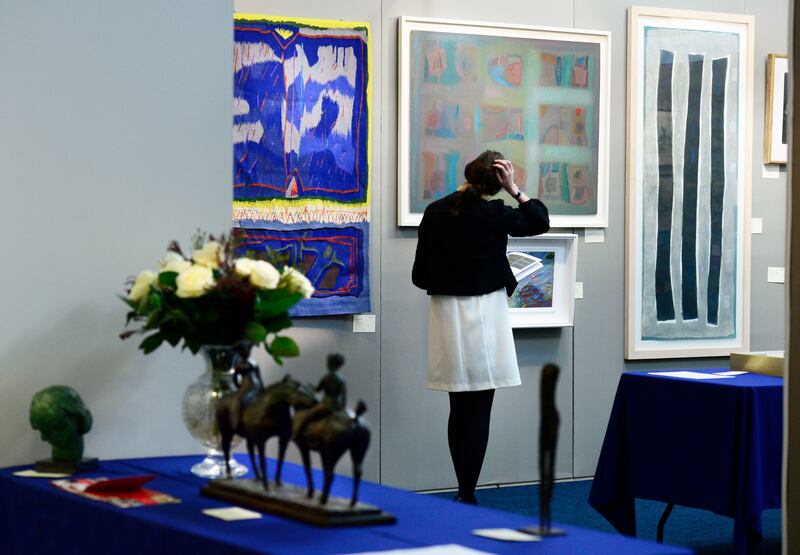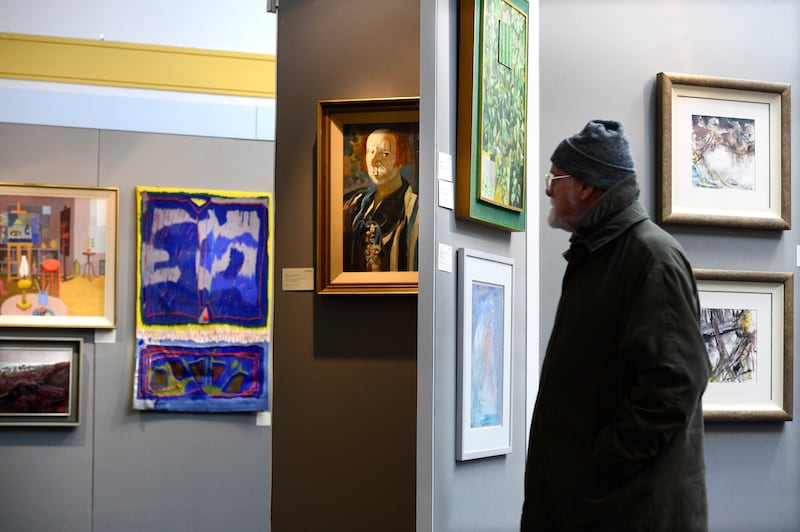Every time a new minister for enterprise is appointed, artist Robert Ballagh writes to them. He’s written to Mary Coughlan, Mary Hanafin, Mary Mitchell O’Connor; to Richard Bruton and Heather Humphreys. He’s asked each of them to take action on the artist resale royalty (ARR), a levy that should be paid every time an artwork is sold by an auctioneer or a dealer for €3,000 or more. The royalty is the responsibility of the Department of Enterprise, a point which ministers for art make to Ballagh. He writes to them too.
One of the gripes he has raised is that artists not paid a royalty due to them could only go to the High Court. “Some ministers ignored me; others said they would get back and never did,” Ballagh says. “The first politician to respond properly was Leo Varadkar [appointed minister for enterprise in June 2020]. As well as the stock Civil Service response, at the end he wrote, in his own handwriting, ‘I consider recourse to the High Court a rather high bar’.”
Over the summer, Varadkar made three changes to Statutory Instrument 312 of 2006, the law that sets down the terms and conditions of ARR. The High Court clause was dropped – artists can now go to the Circuit Court. The time that auctioneers have to respond to a request for information about a sale has been reduced from 90 days to 30. A clause that said auctioneers, when requested, should “make every effort to” provide information to artists about sales has been deleted. Now it simply says they “shall provide the information”.
Ballagh regards these as great improvements. The Circuit Court, he points out, is more accessible and cheaper. “That pernicious phrase ‘make every effort’ left it wide open legally,” he says. “Effectively, auction houses now have a compulsory responsibility to respond to requests for information within 30 days.”
Sliabh Liag trial: How Alan Vial and Nikita Burns were convicted of murdering Robert Wilkin
Happy 90th birthday, Ronnie Delany: from Wicklow’s fields to Olympic gold
Five homes on view this week in Dublin and Wicklow from €195,000 to €600,000
Patrick Freyne: I feel we’re close now, Meghan, so I can speak freely. The right pitch is crucial in lifestyle hucksterism like yours
So does this mean artists, who reckon they are owed over €300,000 in royalties for 2021 alone, will finally stop getting the brush-off?
Auction houses
The ARR is also known as “droit de suite’” due to its origins in France in 1920, when it was introduced to help the widows of artists killed in the first World War who were not entitled to any payment when works were sold. That spirit of “droit de suite” (the right to follow) inspired an EU directive of 2001 which extended the royalty to living artists as well as the estates of dead ones. Artists’ output reduces as they age, and few have pensions. Unlike writers and composers, they can’t rely on royalties in retirement. Many watch in frustration as work from the peak of their careers achieves ever-higher prices in auction houses.
An illustration of this was Ballagh’s iconic painting My Studio, 1969 which the businessman Mike Hogan bought from him in the mid-1990s for “about seven grand”. In 2004, Hogan sold the 6ft by 8ft painting at Whyte’s. It was bought by another businessman, Lochlann Quinn, for €96,000. After the sale, people stopped Ballagh in the street to congratulate him on this new record price, presuming he would benefit financially. “I told them ‘you should be congratulating the people who sold it. I am not entitled to anything’. It is a bizarre and illogical situation,” he said at the time.

The European Commission told member states to introduce the royalty by 2006. Faced with resistance from auctioneers, who claimed the ARR would be bad for business and didn’t fancy the extra admin that came with it, the Irish government did nothing. In April 2006, Ballagh challenged the State in the High Court. He argued, successfully, that its failure to implement the EU directive had cost him money. “I was awarded €5,000 damages plus my legal costs of €78,000,” he says. “Anyone who took a bet of €78,000 to win €5,000 would be regarded as mad. It shows that to say to artists ‘the High Court is your only recourse’ was nonsense.”
The minister for enterprise at the time was Micheál Martin. Facing a court defeat, he introduced the statutory instrument in June 2006. The ARR regime was auctioneer-friendly, however. The EU had allowed member states to set the level at which the royalty would kick in. Britain chose €1,000; Ireland picked €3,000, thereby disqualifying hundreds of artists. The royalty was set at 4 per cent of the sale price on artworks between €3,000 and €5,000, and on a downward sliding scale after that, with a maximum possible payment of €12,500.
In the first year, about 850 artists gave a representative body, the Irish Visual Rights Organisation (Ivaro), authority to collect the royalty on their behalf. Over 2,000 are now registered. Ivaro collected about €240,000 in the first 20 months, but the payments soon tapered off, even when the estates of dead artists were included in 2012.
“How it works is that we request auction houses to provide any information necessary for artists to secure payment of the resale royalty, usually the contact details for the seller of the artwork,” explains Chris Walsh of Ivaro. “Some auction houses are refusing to send us this, citing data protection and GDPR concerns. When we ask for information about sellers, we are largely getting stonewalled. When we do get contact details for sellers, they are hesitant [about paying]. The legislation is toothless.”
According to Ivaro, in 2021 it asked auction houses for the names of the sellers of 681 artworks, and got 166. When Ivaro contacted those sellers, there were just 60 replies. To put it another way, Ivaro claimed €343,168 in royalties from vendors, and got €27,553. And this is just public auctions. “Private gallery sales are covered by ARR legislation,” Walsh says. “However finding the details of when such a sale has occurred is a very difficult task, and an issue faced by artists and estates across Europe, in countries with much better legislation than Ireland’s.”
‘Scandalous’ behaviour
Ballagh, who has not had any royalty payment for about 10 years, is scathing about how some of the auction houses have dealt with ARR, claiming it is “nothing short of scandalous”. In Britain, auctioneers are jointly liable for collection whereas in Ireland all they have to do is supply names of sellers, he points out. “The way the law is here, it places the artist in a very embarrassing situation. The artist has to contact the vendor to say ‘by the way, you sold a picture of mine and you now owe me X amount’. That collector could be someone the artist is hoping to sell to in the future.”
Other artists, just as disillusioned as Ballagh, do not want to publicly criticise auction houses, for fear of being “blackballed”. One of them says: “I think most artists have given up on it. The artist has no way of collecting this. Letters sent to sellers just go in the bin. I’ve never been given the name of a seller of my work, but if I did write to someone and ask for 4 per cent, I’d say there is no chance of getting it.”
Irish artists have no such problems in the UK where the Design and Copyright Society (Dacs) is licensed to collect and distribute royalties and licence fees – it paid £17.2 million last year to 79,000 artists and estates. Colin Davidson, the Belfast artist, says his interactions with Dacs are “rather mundane and smooth; no drama. Every few months I receive a payment as paintings are sold in auction.”

So what is the experience of Irish auction houses? Ian Whyte, chairman emeritus of Whyte’s Auctioneers, says his company’s practice is to ask artists to send an invoice for what they claim to be owed. “We then send on those invoices to the vendors concerned,” he said. “We do not reveal the name or contact addresses of our clients to any third party without their explicit permission. This is in accordance with data protection legislation.”
‘Aggressive’ attempts
Whyte says he has heard about artists harassing sellers, including visiting their houses at night. “Also, the British-based artists’ collecting society have been very aggressive in attempts to collect the ARR levy, including hiring debt collectors and threatening litigation,” he claims. “The British collecting society reported us to the Property Services Regulatory Authority of Ireland for refusing to hand over our clients’ contact details. The PRSA dismissed their complaints.”
Stuart Cole, a director of Adam’s, says his firm “abides really strictly” by the ARR rules. “We make a lot of returns to Ivaro and I believe, anecdotally, we are one of the few,” he said. “This is borne out in information released by Ivaro, showing full engagement from only one auctioneer, although not identified.”
Cole would also like changes to the system. He believes the royalty should be paid by the buyer, as in the UK, rather than by the seller. That way, auctioneers could put the 4 per cent onto the hammer price along with VAT. “Making it payable at the point of purchase would make it more collectable,” Cole points out. “That would also remove the GDPR issue, which is there at the moment, as we can’t release names without the claimant providing ‘sufficient evidence of an entitlement to claim’.
“I have no problem with the artists’ resale right, and we do adhere to it and help Ivaro, but the legislation isn’t clear or well worked out.”
On this, artists and auctioneers agree. Visual Artists Ireland (VAI), which has 3,500 members, says the changes Varadkar has made are welcome, but chief executive Noel Kelly would like to see the threshold reduced to €1,000 “and to set into legislation the obligation of payment through a recognised collecting society such as Ivaro. Without this, our concern is that we will continue to see a high level of monies owed to artists, who will be forced into the courts to get what is due to them”.
Varadkar will rotate back to the taoiseach’s job on December 17th. That means a new minister for enterprise will be appointed. They should expect a letter from Ballagh just after Christmas.













